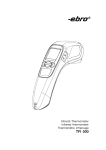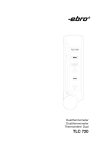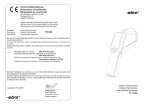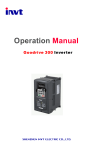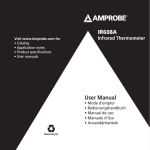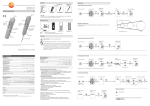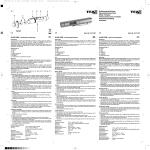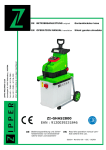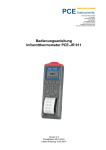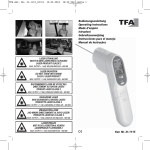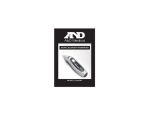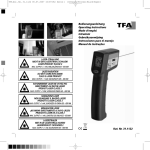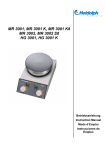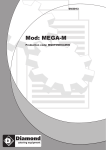Download TFI 400
Transcript
® . TFI 0 40 Infrarot-Thermometer Infrared thermometer Thermomètre infrarouge TFI 400 TFI 400 Deutsch Lesen Sie diese Bedienungsanleitung aufmerksam durch, bevor Sie Ihr neues Infrarotmessgerät TFI 400 in Betrieb nehmen. Die Anleitung führt Sie mit klaren und einfachen Anweisungen in den Umgang mit dem Messgerät ein. Informationen, die für das Verständnis der Funktionsweise nützlich und wichtig sind, finden Sie im Anleitungstext durch Balken markiert. Beachten Sie im Interesse eines gefahrlosen Umgangs mit dem Infrarotmessgerät TFI 400 die mit dem Zeichen versehenen Sicherheitshinweise. Hinweise Warnung vor Laserlicht Richten Sie den Laser nicht direkt oder indirekt über reflektierende Oberflächen auf die Augen. Sicherheitshinweise Dieses Gerät misst Oberflächentemperaturen, keine Kerntemperaturen. Um diese exakt zu messen, benutzen Sie am besten ein normales Kontaktthermometer. Bei Messungen von hygienisch relevanten Temperaturgrenzwerten überprüfen Sie die Anzeige des Infrarotthermometers mit Hilfe eines konventionellen Kontaktthermometers. © Copyright by ebro Electronic GmbH & Co. KG 2 1340 – 1719– 2257 – 05/02 3010-0325 English Read these operating instructions carefully before commissioning your new infrared thermometer TFI 400. The instructions teach you how to operate the device with clear and simple statements. Français Veuillez lire ces instructions de service attentivement avant de mettre en service votre nouvel thermomètre infrarouge TFI 400. Les instructions claires et simples vous apprennent à vous servir du dispositif. Information, which is useful and important for the understanding of the operating principle, is marked with a bar in the instruction text. Les informations utiles et importantes pour la compréhension du principe de fonctionnement sont marquées d’une barre dans le texte d’instruction. For a safe use of the meter, please observe the safety instructions marked with the symbol. Pour une utilisation sans danger de l’instrument de mesure, veuillez observer les instructions de sécurité marquées du symbole . Instructions Consignes Warning Do not point laser directly at eye or indirectly off reflective surfaces. Safety Warnings This unit does not measure internal temperatures. Use in conjunction with a conventional probe thermometer for maximum safety. If readings are within 2.5°C (5°F) of the HACCP danger zone, verify the product temperature with a conventional probe thermometer. Avertissement Ne pointez pas le rayon laser directement dans les yeux ou indirectement sur des surfaces réfléchissantes. Avertissements sanitaires Cet appareil ne mesure pas les températures internes. À utiliser en conjonction avec un thermomètre à sonde conventionnel pour un maximum de sécurité alimentaire. Si l'affichage indique des valeurs se rapprochant de la zone de danger HACCP à 2,5 °C (5 °F) près, vérifiez la température de l'aliment à l'aide d'un thermomètre à sonde. 3 TFI 400 Deutsch Vorsichtsmaßnahmen Das Infrarotmessgerät TFI 400 muss vor folgenden Einflüssen geschützt werden: l EMF (elektromagnetische Felder) von Elektroschweissgeräten und Induktionsheizgeräten l statischer Elektrizität l Thermischer Schock verursacht durch große oder plötzliche Temperaturänderungen – Gerät vor Gebrauch 30 Minuten lang stabilisieren lassen l Gerät nicht auf oder in der Nähe von heißen oder sehr kalten Objekten aufbewahren. 4 English Cautions The Infrared thermometer TFI 400 should be Français Précautions protected from the following: Le thermométre TFI 400 doit être protégés contre : l EMI (Electro Magnetic Interference) from induction heaters and microwave ovens. l les champs électromagnétiques des postes de soudure, les appareils de chauffage par induction l Electro Static Discharge l l’électricité statique l “Thermal shock” caused by large or abrupt ambient temperature changes — allow 30 minutes for unit to stabilize before use when exposed to “thermal shock”. l les chocs thermiques causés par d’importants ou de brusques changements de température - laissez le thermomètre se stabiliser pendant 30 minutes avant de l’utiliser l Do not leave the unit on or near objects of high temperature. l Ne laissez pas le thermomètre sur ou à proximité d’objets à température élevée. 5 TFI 400 Deutsch Inhaltsverzeichnis Hinweise ..........................................2 Inhaltsverzeichnis .............................6 1 Beschreibung ............................8 2 Lieferumfang ............................10 3 Bedienung .............................10 3.1 Einlegen der Batterie ...................10 3.2 Umschaltung °C/°F.....................10 3.3 Emissiongrad .............................12 3.4 Messentfernung u. Messfleckgröße ...............................................12 3.5 Sichtfeld ..............................14 3.6 Temperaturmessung ..................14 3.7 Wichtige Hinweise .....................16 4 Exakte Temperaturmessung............16 4.1 Erfassung der Oberflächentemperaturen von unverpackten xxxLebensmitteln ...................16 4.2 Temperaturmessung von Flüssigkeiten ...............18 4.3 Messen von Lebensmitteln unter Kühlbedingungen ............18 4.4 Messen von Lebensmitteln in Verkaufseinrichtungen ....20 4.5 Wareneingangskontrolle ...........22 5 Kalibrierservice .......................22 5.1 Prüfen der Gerätekalibrierung ....24 5.2 Prüfverfahren .............................24 5.2.1 Kaltprüfung ....................24 5.2.2 Heißprüfung ...................26 6 Wartung ...................................30 7 Was tun wenn .............................30 8 Garantiebedingungen ..................32 9 Technische Daten ................34 6 English Français Contents list Table des matières Instructions ...............................3 Contents list .............................7 1 Description ................................9 2 Extent of Supply .......................11 3 Operation ...............................11 3.1 Assembly of battery ...................11 3.2 Switch between °C/°F.................11 3.3 Emissivity ................................13 3.4 Measuring Distance and Spot Size .............................................13 3.5 Field of View ...........................15 3.6 Temperature measurement........15 3.7 Important Reminders ..............17 4 Accurate Measuring of Temperatures .........................................................17 4.1 Scanning Food Surfaces ............17 4.2 Measuring the temperature of Liquids ....................................19 4.3 Measuring Packaged Products in Cold-Storage Cases ...............19 4.4 Measuring Food in Holding and Serving Areas ........................21 4.5 Measuring Food at the Receiving Dock ........................23 5 Calibration Service .....................23 5.1 Checking Calibration ...................25 5.2 Test Procedure ..........................25 5.2.1 Cold Calibration Check ....25 5.2.2 Hot Calibration Check ......27 6 Maintenance ..........................31 7 Troubleshooting .......................31 8 Warranty ...............................33 9 Technical Data ........................35 Consignes ..................................3 Table des matières .............................7 1 Description ................................9 2 Contenu de l’emballage..................11 3 Utilisation ...............................11 3.1 Placer la pile ..............................11 3.2 Passer des degrés °C/°F.............11 3.3 Émissivité ..................................13 3.4 La distance et la taille de la zone mesure ...................................13 3.5 Champ de visée..........................15 3.6 Utilisation de l’appareil................15 3.7 Rappels ....................................17 4 Mesure précisément la temperature .......17 4.1 Balayage de la surface des aliments .................................17 4.2 Mesure de la température des liquides ..................................19 4.3 Mesure des aliments emballés conservés dans les caissons frigorifiques .............................19 4.4 Mesure des aliments dans les zones d’attente et de service....21 4.5 Mesure à la rampe de réception..................................23 5 Service de calibrage .......................23 5.1 Vérfication de l’étalonnage..........25 5.2 Procedure de test ........................25 5.2.1 Verification par le froid .......25 5.2.2 Verification par le chaud......27 6 Entretien ......................................31 7 En cas de problèmes .......................31 8 Garantie ...............................33 9 Caractéritiques techniques..............35 7 TFI 400 Deutsch 1 1 2 . 3 Beschreibung Das Infrarot-Thermometer TFI 400 ist für vielfältige Mess- und Kontrollaufgaben in Industrie, Handel und Handwerk geeignet. Infrarot-Thermometer messen die Oberflächentemperatur eines Objekts (target). Die Optik des Gerätes erfaßt die emittierte, reflektierte und durchgelassene Wärmestrahlung, die gebündelt und auf einen Detektor fokussiert wird. Die Geräteelektronik wandelt diese Information in einen Temperaturwert um, der auf dem Display angezeigt wird. Bei Geräten mit einem Laser wird der Laser lediglich zum Zielen verwendet. Sehr bald werden Sie feststellen, welche Vorteile Ihnen dieses einfach zu bedienende und schnelle Gerät bei Ihren Routinekontrollen bringt. Einfach zielen, Messtaste drücken. In weniger als einer Sekunde erscheint der Messwert auf dem Display. 1 ........... Laser + Infrarotsensor 2 ........... Display (LCD) 3 ........... Messtaste TFI 400 8 English 1 Description Français 1 Description This infrared thermometer TFI 400 is a handy temperature measuring instrument for various measure and control tasks in the trade, the industry and the laboratory. Infrared thermometers measure the surface temperature of an object. All objects above absolute zero emit infrared energy. The energy from an object is captured by the lens of the IR thermometer, and focused onto a special detector. The signal from the detector is processed by the unit’s analog and digital electronics, and the temperature is displayed as a number on the LCD. The laser spot is used only as an aid for aiming the unit. We are confident that you will find its ease of use and quick temperature measurement to be a useful and time saving tool in your daily program. Le thermomètre à infrarouge mesure la température de surface d’un objet. L’optique de l’instrument capte l’énergie émise, réfléchie et transmise celle-ci est recueillie, puis dirigée sur un détecteur. L’électronique du thermomètre traduit cette information et affiche la température. Le rayon laser (des thermomètres qui en sont équipés) sert uniquement à pointer l’objet. Nous sommes certains que vous apprécierez sa facilité d'emploi et sa rapidité de mesure des températures, et qu'il vous permettra ainsi de gagner du temps lors de l'exécution quotidienne de votre plan. Just aim, pull the trigger, and read the food surface temperature in less than a second. Il vous suffit de viser et d'appuyer sur la gâchette pour voir s'afficher en moins d'une seconde la température de la surface de l'aliment. 1 ........... Laser + Infrared sensor 2 ........... Display (LCD) 3 ........... ON button 1 ........... Laser + infrarouge capteur 2 ........... Affichage 3 ........... Button Marche 9 TFI 400 Deutsch 2 Lieferumfang Überprüfen Sie den Inhalt der Verpackung auf Vollständigkeit und Unversehrtheit. Wenn Sie einen Schaden vorfinden oder Grund zur Beanstandung haben, wenden Sie sich bitte an ebro oder Ihren Händler. Teileliste: C • Thermometer, incl. Batterie • Kalibrierzertifikat • Bedienungsanleitung F 3 Bedienung 3.1 Einlegen der Batterie Entfernen Sie den Batteriefachdeckel auf der Rückseite des Thermometers. Legen Sie einen 9V-Block (z.B. Typ 6 LR 61) in das Batteriefach ein. Achten Sie auf die Polarität! C + A 10 F 3.2 Umschaltung °C/°F - Um zwischen Celsius und Fahrenheit umzuschalten, müssen Sie das Batteriefach öffnen und durch Schieben des Schalters (A) C oder F wählen. English Français 2 Extent of Supply 2 Contenu de l’emballage Check contents of the packing for completeness and integrity. If you discover any damage or have any reason for complaint, please contact ebro or your distributor. Veuillez vérifier que le contenu de l’emballage est complet et intact. Si vous constatez un dommage ou si vous avez un motif de réclamation, adressez-vous à ebro ou àvotre fournisseur. Parts list: Liste des pièces: • Thermometer, incl. battery • Thermomètre, incl. pile • Calibration certificate • Certificat de calibration • Instruction manual • Mode d’emploi 3 Operation 3 Utilisation 3.1 Assembly of battery 3.1 Placer la pile Remove batterycover on the backside of the thermometer. Insert a new 9 V-battery (e.g. type 6 LR 61) into battery compartment. Make sure that the pority is correct! Enlevez le couvercle du compartiment de pile au dos du thermomètre. Vous mettez une 9 bloc V (par ex. type 6 LR 61) dans le compartiment de pile . Faites attention à la polarité! 3.2 Switch between °C/°F 3.2 Passer des degrés °C/°F To switch between Celsius or Fahrenheit, open the battery cover and push switch (A) to select C or F. Pour passer des degrés Celsius aux degrés Fahrenheit, ouvrez le couvercle du logement des piles et appuyez sur le bouton (A) pour sélectionner C ou F. 11 TFI 400 Deutsch 3.3 Emissionsgrad Die meisten im Lebensmittelbereich auftretenden Produkte (einschließlich Wasser, anderer Flüssigkeiten und in Kartons oder Plastikbehältern verpackter Lebensmittel) haben einen Emissionsgrad um 0,97. Das Gerät ist deshalb auf 0,97 voreingestellt. Blanke oder metallische Oberflächen ergeben ungenaue Messungen. Man kann dies umgehen, indem die zu messende Oberfläche mattschwarz gestrichen oder mit mattem Klebeband abgedeckt wird. Warten Sie, bis die Abdeckung den Temperaturwert des Messobjektes angenommen hat. Wenn Sie zum Beispiel einen Grill messen wollen, wählen Sie eine Stelle, an der das Metall bereits geschwärzt ist. 3.4 Messentfernung und Messfleckgröße Mit steigender Messentfernung (D) vergrößert sich der Messfleckdurchmesser. Die ideale Messentfernung liegt zwischen 10 und 20 cm, wobei hier der Messfleckdurchmesser ca. 2,5 bis 5 cm beträgt. 12 English Français 3.3 Emissivity 3.3 Émissivité Most products related to the food industry such as water, liquids, frozen or partially frozen substances in boxes and plastic containers, have an emissivity of about 0.97 (unit is preset for 0.97). Inaccurate readings will result from measuring shiny or polished metal surfaces. To compensate, cover the surface to be measured with masking tape or flat black paint. Allow time for the tape to reach the same temperature as the the material underneath it. Measure the temperature of the tape or painted surface. When measuring a grill, for example, aim the unit at a portion of the grill that has been blackened by the high temperatures. La plupart des produits considérés dans l'industrie alimentaire, comme l'eau, les liquides, ou les produits partiellement congelés présentés dans des boîtes, ont une émissivité de 0,97 (préréglée dans le thermomètre). Des résultats incorrects peuvent s'afficher si vous tentez de mesurer la température de surfaces métalliques brillantes ou polies. Pour compenser la distorsion, couvrez la surface à mesurer à l'aide de papier-cache ou de peinture noire matte. Laissez le temps au papiercache d'atteindre la même température que la surface qu'il recouvre. Mesurez la température de la surface recouverte ou peinte. Lorsque vous mesurez un grill, par exemple, visez la portion du grill qui a été noircie par les températures élevées. 3.4 Measuring Distance and Spot Size 3.4 La distance et la taille de la zone mesurée As the distance (D) from the object increases, the spot size (S) of the area measured by the unit becomes larger. The ideal distance in most food applications is from 4 to 8 inches, measuring a 1-2 inch diameter circle. Au fur et à mesure que la distance (D) entre le thermomètre et l'objet augmente, la taille (S) de la zone mesurée par l'appareil s'accroît. La distance idéale pour la plupart des applications alimentaires est de 10 à 20 centimètres, pour mesurer un cercle de 2,5 à 5 centimètres de diamètre. 13 TFI 400 Deutsch 3.5 Sichtfeld Achten Sie darauf, dass das Messobjekt größer ist als die Messfleckgröße des Gerätes. Je kleiner das Messobjekt, desto näher müssen Sie an das Objekt herangehen. Wenn die Messgenauigkeit von ausschlaggebender Bedeutung ist, sollte das Messobjekt wenigstens doppelt so groß wie die Messfleckgröße sein. 3.6 Temperaturmessung Zum Messen richten Sie das Thermometer auf das Messobjekt und drücken die Messtaste (3). Stellen Sie sicher, dass sich das Messobjekt innerhalb des Messflecks des Infrarotstrahls befindet. Für die meisten Anwendungen empfiehlt sich ein Messabstand zwischen 10 und 20 cm. Siehe auch Kapitel 4 "Exakte Temperaturmessung". Die LCD-Anzeige zeigt die momentane Temperatur in Grad Celsius oder Grad Fahrenheit an. Nach Loslassen der Messtaste wird der Messwert weitere 7 Sekunden lang angezeigt; dabei wird das Wort HOLD (H) angezeigt. Die Anzeige des Batteriesymbols weist auf eine verbrauchte Batterie hin (B). Eine Anzeige der Temperatur entfällt. H HOLD . HOLD B 14 English Français 3.5 Field of View 3.5 Champ de visée Make sure that the target is larger than the unit’s spot size. The smaller the target, the closer you should be to it. When accuracy is critical, make sure the target is at least twice as large as the spot size. Assurez-vous que la cible est plus grande que le spot mesuré par le thermomètre. Plus la cible est petite, plus vous devrez vous en rapprocher. Lorsqu’il est essentiel d’obtenir des mesures précises, veillez à ce que la cible soit au moins deux fois plus grande que le spot mesuré. 3.6 Temperature measurement 3.6 Utilisation de l'appareil To measure a temperature, point the unit at an object and push the ON button (3). Be sure to consider distanceto-spot size ratio and field of view. For most applications, the ideal distance is four to eight inches away from the target. Use the laser only for aiming. See “Accurate Measuring of Temperatures”. Pour mesurer une température, pointez l'appareil sur un objet et appuyez sur la gâchette (3). Veillez à bien estimer le champ de visée et le rapport entre la taille de la zone mesurée et la distance qui vous sépare de l'objet. Dans la plupart des cas, la distance idéale est de 10 à 20 centimètres de la cible. N'utilisez le laser que pour viser. Voir "Comment mesurer précisément la température ". The backlit LCD displays the current temperature in Celsius or Fahrenheit. When the ON button is released, the last reading is held for seven seconds, and the display shows the HOLD (H) icon. The presence of the battery icon indicates a low battery (B). There is no indication of temperature in this case. L’écran à cristaux liquides, rétro-éclairé, affiche la température courante en degrés Celsius ou Fahrenheit. La température restera affichée pendant 7 secondes après avoir relâché le bouton et le mot HOLD (H) (maintenir) apparaît. Lorsque l’icône de la pile apparaît, cela indiqueun faible niveau de charge de la pile (B). 15 TFI 400 Deutsch 3.7 Wichtige Hinweise • Zur Messung von Temperaturen glänzender oder hochpolierter Metalloberflächen (z.B. Edelstahl, Aluminium usw.) wird das Gerät nicht empfohlen. Siehe auch Abschnitt „Emissionsgrad“. • Das Gerät kann nicht durch transparente Oberflächen wie z.B. Glas messen. Statt dessen misst es die Oberflächentemperatur des Glases. • Dampf, Staub, Rauch usw. können die korrekte Temperaturbestimmung behindern. • Wenn Sie Flüssigkeiten messen wollen, rühren Sie diese während der Messung gründlich um! 4 Exakte Temperaturmessung 4.1 Erfassung der Oberflächentemperaturen von unverpackten Lebensmitteln Um festzustellen, ob sich die Temperatur der Lebensmittel im hygienisch unbedenklichen Bereich befindet, messen Sie an verschiedenen Stellen. Sollten Sie eine Temperatur außerhalb des zugelassenen Bereiches messen, überprüfen Sie die entsprechende Stelle mit Hilfe eines geeichten Kontaktthermometers. 16 English Français 3.7 Important Reminders 3.7 Rappels • Not recommended for use in measuring shiny or polished metal surfaces (stainless steel, aluminum, etc.). See “Emissivity.” • The unit cannot measure through transparent surfaces such as glass or plastic. It will measure the surface temperature of the glass instead. • Steam, dust, smoke, etc., can prevent accurate measurement by obstructing the unit’s optics. Hold the unit back and at an angle to ensure the most accurate measurement. • When measuring liquid products, be sure to stir the product vigorously while measuring the surface of the liquid. • • • • Il est déconseillé d’utiliser ce thermomètre pour mesurer la température de surfaces métalliques brillantes ou polies (acier inoxydable, aluminium,etc.). Voir Emissivité. Le thermomètre ne peut pas mesurer la température à travers des surfaces transparentes comme le verre, car il mesure en fait la température de surface du verre. La précision des résultats peut être faussée par la présence de vapeur, de poussière, de fumée, etc. Lorsque vous mesurez des liquides, veillez à les brasser vigoureusement avant d'en mesurer la surface. 4 Accurate Measuring of Temperatures 4 Mesurer précisément la température 4.1 Scanning Food Surfaces 4.1 Balayage de la surface des aliments Scan across the surface of foods in deli lines, salad bars, hot and cold holding trays, ovens, rotisseries, and grills to locate temperatures near or outside of the HACCP food danger zone (4-60°C/ 40-140°F). If a questionable temperature is found, probe the food for precise measurement. Balayez la surface des aliments dans les vitrines de traiteur, les buffets de hors d'œuvres, les bacs pour aliments chauds et froids, les fours, les rôtissoires et les grills pour repérer les températures proches de la zone de danger alimentaire HACCP (4-60 °C / 40-140 °F). Si vous trouvez une température douteuse, sondez l'aliment concerné pour obtenir une mesure précise. 17 TFI 400 Deutsch 4.2 Temperaturmessung von Flüssigkeiten Um die Temperatur von Flüssigkeiten und Quasi-Flüssigkeiten wie z.B. Suppen oder Dressings zu bestimmen, rühren Sie diese während der Messung ständig gut um, damit ein Temperaturausgleich erfolgt. Achtung: Falls sich Dampf auf der Frontlinse des Thermometers niederschlägt, werden die Messwerte ungenau. Richten Sie daher das Thermometer in einem Winkel (ca. 45°) von außerhalb des Dampfbereiches auf die Flüssigkeitsoberfläche. 4.3 Messen von Lebensmitteln unter Kühlbedingungen MILK CREA M Um genaue Messergebnisse bei Produkten zu erzielen, die unter Kühlbedingungen gelagert werden, sollten Sie nach Möglichkeit das Infrarotthermometer außerhalb des Kühlbereiches lassen. MILK CRE AM 18 MILK MI LK English Français 4.2 Measuring the Temperature of Liquids 4.2 Mesure de la température des liquides To get accurate measurements from liquids and semi-liquids, such as soup, stew, chili, salad dressing, etc., stir the liquid to bring the internal temperature to the surface, while taking a measurement with the unit. Pour obtenir des mesures précises pour les liquides et semi-liquides, tels que les soupes, les ragoûts, les sauces de salade, etc., brassez le liquide pour en ramener la température interne à la surface, tout en en prenant la mesure avec l'appareil. Note: If steam condenses on the noncontact thermometer’s lens, it will prevent the unit from taking an accurate temperature measurement. Do not hold the noncontact thermometer directly over the steaming product. Hold the unit above and outside the edge of the container, and aim the unit at a 45° angle to the product’s surface. Remarque : La condensation de vapeur sur la lentille du thermomètre sans contact empêche l'appareil de prendre des mesures de température précises. Ne tenez pas le thermomètre sans contact immédiatement au-dessus d'un produit émettant de la vapeur. Tenez l'appareil au-dessus du récipient et à l'écart du bord, et dirigez-le vers la surface du produit selon un angle à 45°. 4.3 Measuring Packaged Products in Cold-Storage Cases 4.3 Mesure des aliments emballés conservés dans les caissons frigorifiques To accurately measure products held in cold storage, measure the product with the therometer outside of the refrigerated environment whenever possible. Pour mesurer avec précision la température des aliments conservés au froid, tenez l'appareil en dehors de l'environnement réfrigéré dans la mesure du possible. 19 TFI 400 Deutsch Beachten Sie, dass das Gerät nicht durch Glas- oder Kunststofftüren hindurchmessen kann. Öffnen Sie die Tür und messen Sie die Produkte, um zu warme Stellen festzustellen. Das könnte ein Hinweis auf ungenügende Lagerumwälzung oder Luftbewegung sein. Sollte eine Messung von außerhalb des Kühlbereiches nicht möglich sein, geben Sie dem Infrarotthermometer ca. 30 Minuten Zeit, um sich an die Umgebungstemperatur anzupassen. Ein Thermoschock, verursacht durch plötzlichen Wechsel der Umgebungstemperatur des Gerätes, führt zu ungenauen Messergebnissen. 4.4 Messen von Lebensmitteln in Verkaufseinrichtungen Nutzen Sie Ihr Infrarotthermometer um Lebensmitteltemperaturen in Kühlregalen oder -truhen, Infrarotwärmetheken oder auch Fleisch- Käse- und Fischbedientheken zu prüfen. Auch hier gilt - einfach die Messtaste drücken und die Oberfläche der Lebensmittel abtasten. Temperaturen zwischen 4°C und 60°C können hygienisch bedenklich sein. Beachten Sie die Sicherheitshinweise. 20 English The unit will not accurately measure through glass or plastic doors. Open the door, and scan the product for unusually warm spots, or for product that is outside of the food safety temperature zone. This may indicate improper stock rotation or possible airflow blockage. If it is not possible to measure the product from the outside, allow 30 minutes for the unit to stabilize in the refrigerated environment (above 0°C (32°F)) before measuring. Caution: Thermal shock, caused by abrubt changes in ambient temperature, will cause the unit to take inaccurate temperature measurements. 4.4 Measuring Food in Holding and Serving Areas Use your noncontact thermometer to accurately measure products held in cold or hot holding areas, such as open top refrigeration units, salad bars, fresh meat or fish displays, steam tables, and warming ovens. Simply push the ON button and scan across the food surface. Food products in these holding areas must be kept out of the HACCP food temperature danger zone, which is between 4°C and 60°C (40°F and 140°F). See “Food Safety Warnings” for additional food safety information. Français L'appareil n'offrira pas de mesure précise à travers les portes en verre ou en plastique. Ouvrez la porte et balayez chaque aliment à la recherche de zones anormalement tièdes, ou d'aliments dont la température se trouve en dehors de la zone de sécurité. Ceci peut indiquer une mauvaise rotation des stocks ou un blocage de la circulation de l'air. S'il vous est impossible de mesurer le produit de l'extérieur, donnez à l'appareil environ 30 minutes pour se stabiliser dans l'environnement réfrigéré (au-dessus de 0 °C (32 °F)) avant de procéder à la mesure. Attention : Les chocs thermiques provoqués par des changements brus-ques de température ambiante en-traînent des prises de températures erronées. 4.4 Mesure des aliments dans les zones d'attente et de service Utilisez votre thermomètre sans contact pour mesurer avec précision les aliments gardés dans les zones d'attente chaudes ou froides, telles que les bacs de réfrigération ouverts, les buffets de hors d'œuvres, les étals de viande ou de poisson, les tables à vapeur et les chauffe-plats. Il vous suffit d'appuyer sur la gâchette et de balayer la surface de l'aliment. Voir " Avertissements sanitaires " pour plus d'informations sur la sécurité alimentaire. 21 TFI 400 Deutsch 4.5 Wareneingangskontrolle Auch zur Überprüfung der Temperaturen bei der Wareneingangskontrolle bietet sich das Infrarotthermometer an. Schnell sind Temperaturabweichungen eingekreist und können dann mittels anderer Temperaturmessverfahren exakt erfasst werden. Sollte eine der fraglichen Temperaturen innerhalb des Bereiches zwischen 4°C und 60°C liegen, empfehlen wir ein geeichtes Thermometer zur exakten Temperaturmessung heranzuziehen. 5 Kalibrierservice Um eine hohe Messgenauigkeit zu garantieren, muss das Infrarot-Thermometer TFI 400 einmal jährlich kalibriert werden. Dazu bietet ebro Electronic GmbH & Co. KG einen Service an. Eine Überprüfung des Gerätes können Sie auch selbst durchführen. Dies ist ausführlich in den nächsten Kapiteln beschrieben. 22 English Français 4.5 Measuring Food at the Receiving Dock 4.5 Mesure à la rampe de réception You can also use your infrared thermometer to accurately measure perishable products at the receiving dock. When a delivery of fresh or frozen food arrives, check that the products are all at the proper temperatures. Check for warm spots in products that have been stacked unevenly or too high. If any questionable temperatures are found in the product, be sure to use your contact probe thermometer to verify that the food is being kept out of the Temperature Danger Zone. Vous pouvez aussi utiliser votre thermomètre sans contact pour mesurer avec précision les denrées périssables à la rampe de réception. Lorsque vous recevez une livraison d'aliments frais ou congelés, vérifiez que les produits, les caisses d'expédition et l'intérieur du camion de livraison sont bien à la température appropriée. Chercher des zones tièdes dans les produits qui ont été empilés de façon irrégulière ou trop haut. Si vous obtenez le moindre réultat douteux, n'oubliez pas de répéter la mesure à l'aide de votre thermomètre à sonde pour vous assurer que la température de l'aliment est bien en dehors de la zone de danger (4 - 60 °C/40 - 140 °F). 5 Calibration Service 5 Service de calibrage In order to guarantee a high measuring precision, the thermometer must be calibrated every year. Therefore ebro Electronic GmbH & Co. KG offers a calibration service. Pour garantir une bonne précision de la mesure, le thermomètre doit être calibré chaque année. Pour cela, ebro vous propose un service de calibrage. A simple check of accuracy can be carried out by yourself. The details are described in the following chapters. Vous pouvez aussi effectuer un contrôle de l'appareil vous–même. Ceci est décrit en détail dans les prochains chapitres. 23 TFI 400 Deutsch 5.1 Prüfen der Gerätekalibrierung Sie sollten regelmäßig die Kalibrierung Ihres Infrarotthermometers überprüfen. Das sichert Ihnen die höchstmögliche Genauigkeit bei der Temperaturmessung. Die Kalibrierung mit kaltem Wasser ist hierbei die eine gute Methode, da die Temperatur stabil gehalten werden kann. Falls Sie feststellen, dass Ihr Gerät Abweichungen zeigt, senden Sie es an den Hersteller, um es neu kalibrieren zu lassen. 5.2 Prüfverfahren 5.2.1 Kaltprüfung 1. Füllen Sie ein gut isolierendes Gefäß (z.B. Thermosgefäß) bis zur Hälfte mit zerhacktem Eis und und füllen Sie dann mit kaltem Wasser auf. 2. Bestimmen Sie nun die Temperatur dieses Wasser-Eis-Gemisches mit Hilfe eines geeichten Kontaktthermometers, wobei Sie gründlich rühren sollten. Warten Sie bis sich die Temperaturanzeige stabilisiert hat. 24 English 5.1 Checking Calibration Français 5.1 Vérification de l'étalonnage de l'appareil You should routinely check your unit’s calibration, so that you can be sure you are getting the most accurate temperature measurement. The cold calibration method is more reliable because the cold water holds a more stable temperature. If you find that your thermometer is not measuring correctly, send your unit back to ebro. Pensez à vérifier régulièrement l'étalonnage de votre appareil pour vous assurer que vous obtenez des mesures de température précises. La méthode d'étalonnage par le froid est plus fiable parce que l'eau froide garde une température plus constante. S'il s'avère que votre thermomètre sans contact ne mesure pas les températures de surface avec exactitude, renvoyez-le pour le faire étalonner en usine. Suivez les instructions pour vérifier l'étalonnage. 5.2 Test Procedure 5.2 Procédure de test de l'étalonnage 5.2.1 Cold Calibration Check 1. Fill a large styrofoam cup (10 ounces or larger) halfway to the surface with crushed ice. Add cold tap water to 1/2 to 1 inch below the rim of the cup. Tip: Two cups, one inside the other, will provide better insulation and more stable temperatures throughout the test. 2. Immerse the tip of an accurately calibrated contact probe thermometer into the water, and vigorously stir the water’s surface with the probe for one minute, or until contact probe temperature stabilizes. 5.2.1 Vérification de l'étalonnage par le froid 1) Remplissez à demi un gobelet de polystyrène de 30 cl ou plus avec de la glace pilée. Ajoutez de l'eau du robinet (froide) jusqu'à 1 ou 2 centimètres du bord. Conseil: Deux gobelets emboîtés l'un dans l'autre offrent une meilleure isolation et des températures plus stables au cours du test. 2) Immergez le bout d'un thermomètre sondeparfaitement calibré dans l'eau et brassez vigoureusement la surface avec la sonde pendant une minute ou jusqu'à ce que la température de la sonde se stabilise. 25 TFI 400 Deutsch 3. Nach dem Stabilisieren des mit dem Kontaktthermometer in der Mitte der Flüssigkeit gemessenen Temperaturwertes rühren Sie mit einem Rührstab weiter und messen nun die Temperatur mit Hilfe des Infrarotthermometers. 4. Die angezeigte Temperatur sollte höchstens um ± 1°C vom Wert des Kontaktthermometers abweichen. 5.2.2 Heißprüfung Prinzipiell erfolgt hier die Prüfung wie oben beschrieben, nur dass nun heißes Wasser eingesetzt wird. 1. Füllen Sie in ein gut isoliertes Gefäß (z.B. Thermosgefäß) warmes Wasser von mindestens 60°C. 2. Wiederholen Sie nun die Schritte 2 und 3 der Kaltprüfung. Wichtig: Die Wasseroberfläche muß während der IR-Temperaturmessung umgerührt werden. 26 English Français 3. When the probe temperature has stabilized, continue stirring the water with a plastic straw or swizzle, while taking simultaneous temperature measurements with the probe and noncontact thermometer. Hold thenoncontact thermometer within 3 inches of the surface of the water for most accurate measurement. 4. Infrared temperature measurement should be within ±1°C (±2°F) of probe reading or 0°C (32°F). 3) Lorsque la température de la sonde est stabilisée, continuez à brasser l'eau avec une paille ou un bâtonnet mélangeur, tout en prenant des mesures de température simultanées avec la sonde et le thermomètre sans contact. Tenez le thermomètre sans contact à moins de 7,5 centimètres de la surface de l'eau pour obtenir une mesure précise. 4 ) Les températures mesurées par infrarouges devraient se trouver à ± 1 °C (± 2 °F) de celles affichées par la sonde, à 0 °C (32 °F). 5.2.2 Hot Calibration Check 5.2.2 Vérification de l’étalonnage par le chaud Use the same procedure as cold calibration, substituting hot water. 1. Fill a large styrofoam cup (10 ounce or larger) up to 1/2 to 1 inch below the rim with hot water (>140°F/60°C). Hot tap water is adequate for the procedure. 2. Repeat steps 2 and 3 above. Utilisez la même procédure que pour l'étalonnage par le froid, en replaçant l'eau froide par de l'eau chaude. 1) Remplissez un gobelet de polystyrène de 30 cl ou plus avec de l'eau chaude (> 60 °C / 140 °F) jusqu'à 1 ou 2 centimètres du bord. L'eau chaude du robinet convient pour cette procédure. 2) Répétez les étapes 2 et 3, ci-dessus. Important : la surface de l'eau doit être agitée pendant la prise de température infrarouge. Important: The surface of the water must be agitated while taking the IR temperature measurement. 27 TFI 400 Deutsch 3. Der Infrarotmesswert sollte höchstens um ± 2°C von dem des Kontaktthermometers abweichen. Achtung: • Richten Sie das Infrarotthermometer von außerhalb des Dampfbereiches auf die Oberfläche des Wassers. Der Abstand sollte ca. 7 - 8 cm betragen. • Vermeiden Sie das Beschlagen der Frontlinse des Gerätes. Sollte es doch dazu kommen, so lassen Sie diese von alleine trocknen. Nicht abwischen! • Die Heißprüfung sollte als Mittel zur generellen Genauigkeitsprüfung angewandt werden. Auf Grund des Emissionsgrades von Wasser und der schnellen Abkühlung der Wasseroberfläche sind Abweichungen der Infrarottemperatur um ±2°C von der Messtemperatur des Kontaktfühler im Rahmen des Erlaubten. 28 English Français 3. Infrared measurement temperatures should be within ±2°C (±3.5°F) of the probe reading. 3) Les températures mesurées par infrarouges devraient se trouver à ± 2 °C (± 3,5 °F) de celles affichées par la sonde. Cautions: Précautions : • Hold the infrared thermometer outside the rim of the cup, away from the steam, at approximately 3 inches from the surface of the water. • Avoid steam condensation on the IR thermometer’s lens. If this should happen, do not wipe the lens; let it dry at room temperature, then resume measurement. • The hot verification should be used as a general check on the accuracy of the IR thermometer. Due to the varying emissivity of water and the evaporative cooling of the surface of the water, you should consider your IR thermometer to be accurately calibrated if the reading is within ±2°C (±3.5°F) of the probe reading. • Tenez le thermomètre à infrarouges à l'écart du bord du gobelet, en dehors de la vapeur, à environ 7,5 centimètres de la surface de l'eau. • Veillez à ce que la vapeur ne se condense pas sur la lentille du thermomètre à infrarouges. Si cela se produisait, n'essuyez pas la lentille ; laissez-la sécher à température ambiante, puis recommencez la mesure. • La vérification du chaud doit être envisagée comme une vérification générale de laprécision du thermomètre à infrarouges. En raison de l'émissivité variable de l'eau et du refroidissement de la surface dû àl'évaporation, vous pouvez considérer que votre thermomètre à infrarouges est correctement étalonné lorsque la température affichée se trouve à ± 2 °C (± 3,5 °F) de la température de la sonde. 29 TFI 400 Deutsch 6 Wartung Reinigung der Linse: Blasen Sie lose Teilchen mit reiner Preßluft weg. Zurückbleibende Verunreinigungen werden dann vorsichtig mit einem weichen Pinsel entfernt. Wischen Sie die Oberfläche vorsichtig mit einem feuchten Wattebausch ab. Der Wattebausch kann mit Wasser befeuchtet werden. Hinweis: KEINE Lösungsmittel zur Reinigung der Linse verwenden. Reinigung des Gehäuses: Mit Seifenlösung und Schwamm oder einem weichen Tuch reinigen. Hinweis: Das Gerät darf NICHT in Wasser eingetaucht werden. 7 Was tun wenn ... HOLD Störung Abhilfe Temperatur oberhalb oder unterhalb des Messbereichs Objekttemperatur muss innerhalb des Messbereiches sein Batterie verbraucht Batterie erneuern HOLD 30 English Français 6 Maintenance 6 Entretien Cleaning the lens: Blow off loose particles using clean compressed air. Gently brush remaining debris away with a camel's hair brush. Carefully wipe the surface with a moist cotton swab. The swab may be moistened with water. Nettoyage de l’optique: ôtez les particules libres en soufflant de l’air comprimé propre. Eliminez les débris restants en brossant délicatement à l’aide d’une brosse en poils de chameau. Essuyez avec précaution la surface à l’aide d’un coton-tige humide (que vous pouvez humidifier avec de l’eau). Remarque: N’utilisez PAS de solvant pour nettoyer l’optique en plastique. Nettoyage du boîtier: utilisez une éponge humide ou un linge doux imbibés d’eau savonneuse. Remarque: N’immergez PAS le thermomètre dans l’eau. Note: DO NOT use solvents to clean the plastic lens. Cleaning the unit’s housing: If the case becomes dirty, use soap and water on a damp sponge or soft cloth. Note: DO NOT submerge the unit in water. 7 Troubleshooting 7 En cas de problèmes Possible cause Remedy Cause possible Remède Target temperature is over or under range Select target within specifications Température cible hors limites Sélectionnez une cible conforme aux spécifications Battery empty Replace battery Pile dèchargée Vérifier et/ou changer la pile 31 TFI 400 Deutsch 8 Garantiebedingungen ebro gewährleistet, dass das Produkt bei normalem Einsatz und Bedienung für den Zeitraum von zwei Jahren, gerechnet vom Datum des Erwerbs an, mit Ausnahme der nachstehend aufgeführten Umstände, frei von Material- und Herstellungsfehlern ist. Diese Garantie erstreckt sich nur auf den Erstkäufer (ein Kauf bei ebro oder von einem lizensierten Händler gilt als Erstkauf). Die Garantie bezieht sich nicht auf die Batterien. Die Garantie gilt nicht für Produkte, die mißbraucht oder vernachlässigt, in einen Unfall verwickelt oder unsachgemäßen Betriebs- oder Lagerbedingungen unterworfen wurden. Im Fall eines Ausfalls des Produkts während der Garantiefrist ist das Produkt zwecks Reparatur oder Austausch an ebro bzw. an den Händler zurückzusenden, von dem das Gerät erworben wurde. Der alleinige Anspruch des Käufers innerhalb der Garantiefrist besteht im Austausch oder der Reparatur des Geräts oder der Rückerstattung des Kaufpreises. Die vorstehende Garantie gilt anstelle aller anderen Garantien, einschließlich, jedoch ohne Beschränkung, aller stillschweigender Garantien der Verkäuflichkeit, der Handelstauglichkeit und der Eignung für einen bestimmten Zweck oder eine besondere Verwendung. ebro übernimmt keinerlei Verantwortung für besondere, zufällige oder Folgeschäden, weder durch Vertrag, Schadenersatzanspruch noch anderweitig. 32 English Français 8 Warranty 8 Garantie ebro warrants this product to be free from defects in material and workmanship under normal use and service for a period of two years from date of pur-chase, except as hereinafter provided. This warranty extends only to the original purchaser (a purchase from ebro or ebro-licensed distributors is an original purchase). This warranty shall not apply to batteries. The warranty shall not apply to any product which has been subject to misuse, neglect, accident, or abnormal conditions of operation or storage. In the event of failure under warranty, return this product to ebro or to the distributor or retailer from whom it was purchased for replacement or repair. Purchaser’s exclusive remedy under warranty shall be replacement, repair, or refund of the purchase price. The foregoing warranty is in lieu of all other warranties, expressed or implied, including but not limited to any implied warranty of merchantability, fitness, or adequacy for any particular purpose or use. ebro shall not be liable for any special, incidental, or consequential damages, whether in contract, tort, or otherwise. ebro garantit que ce produit est exempt de défauts de fabrication et de matériaux utilisés pour celle-ci dans des conditions normales d’utilisation et assure sa réparation pendant une période de deux ans à compter de la date d’achat du produit, sauf indications contraires mentionnées ciaprès. Cette garantie n’est accordée qu’à l’acheteur d’origine (un achat auprès de ebro ou de l’un de ses distributeurs agréés est considéré comme un achat d’origine). Cette garantie ne s’applique ni aux piles ni dans le cas ou le produit a été l’objet d’un mauvais traitement, de négligence, d’un accident ou a été utilisé ou stocké dans des conditions anormales. En cas de panne au cours de la période de garantie, retournez le produit au distributeur ou au revendeur auprès duquel il a été acheté pour en obtenir le remplacement ou la réparation. L’unique recours sous garantie consenti à l’Acheteur consiste à remdplacer, réparer ou rembourser le prix d’achat du produit. La présente garantie tient lieu de toute autre garantie, expresse ou implicite, y compris mais sans s’y limiter, toute garantie implicite de qualité marchande, de convenance ou d’adéquation à un but ou usage particulier. ebro ne saurait en aucun cas être tenue responsable de tout dommage particulier, indirect ou fortuit, du fait de la responsabilité contractuelle, délictuelle ou quasi-délictuelle, ou autre. 33 TFI 400 Deutsch 9 Technische Daten Messbereich ................. - 30 bis + 200°C (-25 to 400°F) Auflösung .................... 0,5°C bzw. 1°F Genauigkeit bei Umgebungstemperatur von 21-25°C (70-77°F): Unter 0°C (32°F): ......... ±1°C (±2°F) + .................................. 0,1Grad/Grad 0 ... +65°C (32 ...150°F): ±1°C (±2°F) Über 65°C (150°F):..... ±1,5% vom MW Wiederholgenauigkeit .. innerhalb der .................................. angegebenen Ge.................................. nauigkeit Reaktionszeit ............... ca. 0,5 Sekunden Spectralbereich ............ 8–14 µm Emissionsfaktor ........... fix 0,97 Arbeitstemperatur ........ 0 bis + 50°C Relative Feuchte ......... 93% bei 30°C Lagertemperatur .......... - 20 bis + 65°C (ohne Batterie) Gehäusematerial .......... ABS Schutzklasse ............... IP 10 Gewicht incl. Batterie ... ca. 160g Abmessungen .............. 190 x 45 x 38 mm Technische Änderungen vorbehalten 34 English Français 9 Technical Data 9 Caractéristiques techniques Temperature Range ...... - 30 bis + 200°C (-25 to 400°F) Plage de mesures ......... de - 30 à + 200°C (de -25 à 400°F) Temperature Display .... 0,5°C bzw. 1°F Résolution ................... 0,5°C resp. 1°F Accuracy at ambient temperature from 21 to 25°C (70-77°F): Exactitude à une température d'environs de 21-25°C (70-77°F): below 0°C (32°F): ........ ±1°C (±2°F) + .................................. 0.1 degree/degree au–dessous 0°C (32°F):±1°C (±2°F) + .................................. 0,1 degré/degré 0 to +65°C (32 to 150°F): ±1°C (±2°F) de 0 à +65°C (de 32 à150°F): ±1°C (±2°F) above 65°C (150°F):..... ±1.5% of reading au–dessus +65°C (150°F): ±1,5% de .................................. valeur de mesurer Repeatability ................ within accuracy .................................. specifications of .................................. the unit Précision de répéter ..... à l'intérieur de la .................................. précision indiquée Response Time ............ approx. 0.5 sec. Temps de résponse ...... 0,5 s env. Spectral Response ...... 8–14 µm Domaine de spectre ..... 8 à 14 µm Emissivity ..................... preset at 0.97 Facteur d'émission ...... fix 0,97 Operating Range .......... 0 to + 50°C Température de service de 0 à + 50°C Relative Humidity ......... 93% at 30°C Humidité relatif ......... 93% @ 30°C Storage Temperature ... - 20 to + 65°C (without battery) Température de stockage (sans pile) ..................... de -20 à + 65°C Housing material ......... ABS Boîter ........................... ABS Protection class ........... IP 10 Indice de protection ..... IP 10 Weight incl. battery ...... approx. 160g Mass incl. pile .............. 160g env. Dimensions .................. 190 x 45 x 38 mm Dimensions .................. 190 x 45 x 38 mm Subject to technical change without notice Sujet à modifications techniques sans avis préalable 35 Konformitätserklärung Declaration of conformity Déclaration de conformité ebro Electronic GmbH & Co. KG Peringerstraße 10 D-85055 Ingolstadt erklärt in alleiniger Verantwortung, dass das Produkt declares under its sole responsibility that the product déclare sous sa seule responsabilité que le produit Geräteart: Description: Description: Infrarot-Thermometer TFI 400 Infrared Thermometer TFI 400 Thermomètre infrarouge TFI 400 auf das sich diese Erklärung bezieht, mit den folgenden Normen oder normativen Dokumenten übereinstimmt: to which this declaration refers, complies with the following standards or normative documents: auquel cette déclaration se réfère, est conforme aux normes et aux documents normatifs suivants: Techn. Vorschriften: Documents: EN 61326-1 Références: Im Bereich zwischen 142 MHz und 1000 MHz bei 3 V/m kann es sein, dass das Gerät nicht der angegebenen Genauigkeit entspricht. Between 142 MHz and 1000 MHz at 3 V/m, the instrument may not meet its stated accuracy. Entre 142 MHz et 1000 MHz à 3 v/m, il est possible que l’instrument ne soit pas conforme à cette précision nominale. ®




































